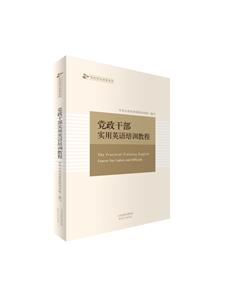党政干部实用英语培训教程
节选
[
Culture Background The History of Mother’s Day The earliest Mother’s Day celebrations are traced back to the spring celebrations of ancient Greece in honor of Rhea, the Mother of the Gods. During the 1600’s, England celebrated a day called “Mothering Sunday”, celebrated on the 4th Sunday of Lent . “Mothering Sunday” honored the mothers of England. During this time many of the England’s poor worked as servants for the wealthy. As most jobs were located far from their homes, the servants would live at the houses of their employers. On Mothering Sunday the servants would have the day off and were encouraged to return home and spend the day with their mothers. A special cake, called the mothering cake, was often brought along to provide a festive touch. As Christianity spread throughout Europe the celebration changed to honor the “Mother Church” — the spiritual power that gave them life and protected them from harm. Over time the church festival blended with the Mothering Sunday celebration. People began honoring their mothers as well as the church. In the United States Mother’s Day was first suggested in 1872 by Julia Ward Howe as a day dedicated to peace. In 1907 Ana Jarvis, from Philadelphia, began a campaign to establish a national Mother’s Day. Ms. Jarvis persuaded her mother’s church in Grafton, West Virginia to celebrate Mother’s Day on the second anniversary of her mother’s death, the 2nd Sunday of May. By the next year Mother’s Day was also celebrated in Philadelphia. Ms. Jarvis and her supporters began to write to ministers, businessman, and politicians in their quest to establish a national Mother’s Day. It was successful, by 1911 Mother’s Day was celebrated in almost every state. President Woodrow Wilson, in 1914, made the official announcement proclaiming Mother’s Day a national holiday that was to be held each year on the 2nd Sunday of May. While many countries of the world celebrate their own Mother’s Day at different times throughout the year, there are some countries such as Denmark, Finland, Italy, Turkey, Australia, and Belgium which also celebrate Mother’s Day on the second Sunday of May. ——选自《英语沙龙》2004(1月—6月)合订本 译 文 *早的母亲节要追溯到古希腊为纪念众神之母瑞亚而举行的春季庆典。 在17世纪,英国庆祝一个叫“省亲日”的节日,庆典在四旬斋的第四个星期日举行。“省亲日”是英国人为表示对母亲的尊敬而设立的。当时,许多英国穷人都给富人当奴仆。由于多数工作地都离家很远,所以仆人们总是住在他们的雇主家里。在省亲日这天,仆人们常放假一天,可以回家和母亲团聚。为增加节日的气氛,他们常捎带一种特制的蛋糕,叫省亲蛋糕。 当基督教传遍欧洲的时候,庆祝活动演变成了颂扬“母教”——给予他们生命和保护他们免遭伤害的精神力量。渐渐地,宗教节日和省亲日的庆祝活动相互交融,人们开始既敬重母亲,又颂扬教会。 在美国,母亲节是1872年朱莉亚?沃德?豪作为和平日首次提出的。 1907年,来自费城的阿纳?贾维斯为确立一个全国性的母亲节开始了一项运动。贾维斯女士说服西弗吉尼亚州格拉夫顿她母亲的教会在她母亲逝世两周年纪念日——5月的第二个星期日,庆祝母亲节。到第二年,费城也开始庆祝母亲节。 贾维斯女士和她的支持者开始给牧师、商人、政治家写信,力求确立一个全国性的母亲节。这件事成功了。到1911年,几乎所有州都庆祝母亲节。1914年,伍德罗?威尔逊总统发表官方通告,宣布母亲节为一个全国性的节日,在每年5月的第二个星期日庆祝。 虽然世界上很多国家一年中在不同时间庆祝他们自己的母亲节,但诸如丹麦、芬兰、意大利、土耳其、澳大利亚和比利时等国家也是在5月的第二个星期日庆祝母亲节。 ……
]
本书特色
[
《党政干部实用英语培训教程》是党政干部英语教材的一次积极探索和有益尝试。每章围绕一个主题,从社会、文化、政治、教育等方面为党政干部的外语教学和自学提供有益帮助。 一本适合于党政干部的基础性、实用性英语学习用书!
]
内容简介
[
《党政干部实用英语培训教程》包含8个单元,词汇起点为800个。内容包括口语练习、课文学习、语言技能、美文赏析和轻松一刻5个模块。为了提高学员的学习兴趣,打牢学习基础,便于学员在工作实际中使用本书,书后附录部分有英语音标常识介绍、诗歌欣赏、美国主要节日、天津市组织机构名称英文译法、职务职称英文译法等内容。
]
作者简介
[
中共天津市委党校外语组,主要负责本单位研究生部、培训部及进修部学员的英语教学。现共有在职员工8人,其中1人有副高级职称。所有教师在党校均从事英语教学10年以上,有着丰富的教学经验。
]
目录
Unit 1Dialogue A Asking the Way (1)Dialogue B Asking the way (2)Passage A BritainPassage B A New WorldEssay Appreciation Three Days to See (Excerpts)Culture BackgroundA StoryUnit 2Dialogue A Check inDialogue B Check outPassage A Does Money Buy Happiness?Passage B How Names are Called in AmericaEssay Appreciation I Have a DreamCulture BackgroundA StoryUnit 3Dialogue A Eating outDialogue B A Potluck DinnerPassage A Presidential Class (1)Passage B Presidential Class (2)Essay Appreciation Working Together Toward a Better Future for Asia and the WorldCulture BackgroundA Story
封面

书名:党政干部实用英语培训教程
作者:本书编委会
页数:221
定价:¥38.0
出版社:天津人民出版社
出版日期:2015-04-01
ISBN:9787201092140
PDF电子书大小:126MB
